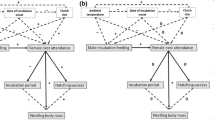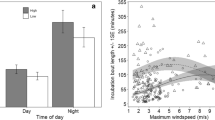Abstract
Energetic trade-offs between time spent on incubation and times spent on foraging for nesting birds give individuals in good body condition the possibility to incubate more continuously. In the present paper, the incubation behaviour of female barnacle geese Branta leucopsis was quantified in a colony in Svalbard. Females were weighted in early incubation and feeding recess lengths and frequencies were recorded. The feeding behaviour during the course of incubation was significantly correlated to by body mass, and heavy females had both fewer and shorter feeding recesses than lighter females. Moreover, there was an increase in the number of feeding recesses and the total feeding time as the incubation period progressed. Neither clutch size nor egg laying date had an effect on incubation behaviour. However, clutch size was positively related to female body mass suggesting that high-quality females produce large clutches but also allocate more body reserves to incubation. Females left the nest to feed at all times of the day, but more frequently during day time. This was not related to their body mass. Females presumably leave their nest at the time of day when the costs to reheat eggs are at a minimum. The diurnal rhythm may also be adjusted to the activity by egg predators. Overall the results support the state-dependent hypothesis for incubation behaviour, suggesting that body condition at the start of incubation is an important factor for incubation behaviour in barnacle geese.


Similar content being viewed by others
References
Afton AD (1980) Factor affecting incubation rhythms of Northern Shovelers. Condor 82:132–137
Afton AD, Paulus SL (1992) Incubation and brood care. In: Batt BD, Afton AD, Anderson MG, Ankney CD, Johnson DH, Kadlec JA, Krapu GL (eds) Ecology and management of breeding waterfowl. University Minnesota Press, Minneapolis, pp 62–108
Aldrich TW, Raveling DG (1983) Effects of experience and body weight on incubation behaviour of Canada Geese. Auk 100:670–679
Alisauskas RT, Charlwood JW, Kellett DK (2006) Vegetation correlates of the history and nesting density by Ross’s geese and lesser snow geese at Karrak lake, Nunavut. Arctic 59:201–210
Alsos IG, Elvebakk A, Gabrielsen GW (1998) Vegetation exploitation by barnacle geese Branta leucopsis during incubation on Svalbard. Polar Res 17:1–14
Ankney CD, MacInnes CD (1978) Nutrient reserves and reproductive performance of female lesser snow geese. Auk 95:459–471
Bentzen RL, Powell AN, Phillips LM, Suydam RS (2010) Incubation behaviour of king eiders on the coastal plain of northern Alaska. Polar Biol 33:1075–1082
Choinière L, Gauthier G (1995) Energetics of reproduction in female and male greater snow geese. Oecologia 103:379–389
Clark CW, Mangel M (2000) Dynamic state variable models in ecology: methods and applications. Oxford Unversity Press
Cooper JA (1978) The history and breeding biology of the Canada Geese of Marshy Point, Manitoba. Wildl Monogr, vol 61
Deeming DC (2002) Avian incubation: behaviour, environment and evolution. Oxford University Press, New York
Dickey MH, Gauthier G, Cadieux MC (2008) Climatic effects on the breeding phenology and reproductive success of an arctic-nesting goose species. Global Ch Biol 14:1973–1985
Eichholz MW, Sedinger JS (1999) Regulation of incubation behaviour in black brant. Can J Zool 77:249–257
Eichhorn G, van der Jeugd HP, Meijer HAJ, Drent RH (2010) Fueling incubation: differential use of body stores in arctic- and temperate breeding barnacle geese (Branta leucopsis). Auk 127:162–172
Ely CR, Raveling DG (1984) Breeding biology of Pacific White-fronted geese. J Wildl Manage 48:823–837
Erikstad KE (1986) Relationship between weather, body condition and incubation rhythm in Willow Grouse. Fauna Norv Ser C Cinclus 9:7–12
Erikstad KE, Tveraa T (1995) Does the cost in incubation set limits to clutch size in Common Eiders Somateria mollissima? Oecologia 103:270–274
Erikstad KE, Bustnes JO, Moum T (1993) Clutch-size determination in precocial birds: a study of the common Eider. Auk 110:623–629
Fox TA, Bergersen E (2005) Lack of competition between barnacle geese Branta leucopsis and pink-footed geese Anser brachyrhynchus during the pre-breeding period in Svalbard. J Avian Biol 36:173–178
Frafjord K (1992) Behavioural ecology and behavioural energetics in the arctic fox alopex lagopus. Dissertation, University of Bergen, Norway
Ganter B, Cooke F (1996) Pre-incubation feeding activities and energy budgets of snow geese: can food on the breeding grounds influence fecundity? Oecologia 106:153–165
Gorman HE, Nager RG (2003) State-dependent incubation behaviour in the Zebra Finch. Anim Behav 65:745–754
Hanssen SA, Hasselquist D, Folstad I, Erikstad KE (2005) Cost of reproduction in a long-lived bird: incubation effort reduces immune function and future reproduction. Proc R Soc B 272:1039–1046
Harvey JM (1971) Factors affecting blue goose nesting success. Can J Zool 49:223–234
Heaney V, Monaghan P (1996) Optimal allocation of effort between reproductive phases: the trade-off between incubation costs and subsequent brood rearing capacity. Proc R Soc Lond B 263:1719–1724
Hepp GR, Kennamer RA, Harvey WF (1990) Incubation as a reproductive cost in female wood ducks. Auk 107:756–764
Hepp GR, Folk TH, Manlove CA (2005) Nest temperature, incubation period, and investment decisions of incubating wood ducks Aix sponsa. J Avian Biol 36:523–530
Inglis IR (1977) The breeding behaviour of the pink-footed goose: behavioural correlates of nesting success. Anim Behav 25:747–764
Jónsson JE, Afton AD, Alisauskas RT (2007) Does body size influence nest attendance? a comparison of Ross’s geese (Chen rossii) and the larger, sympatric snow geese (C. Caerulescens caerulescens). J Ornithol 148:549–555
Lessells CM, Sibly RM, Owen M, Ellis S (1979) Weights of female barnacle geese during breeding. Wildfowl 30:72–74
McNamara JM, Houston AI (1996) State-dependent life histories. Nature 380:215–221
Mehlum F (1991) Egg predation in a breeding colony of the common eider Somateria mollissima in Kongsfjorden, Svalbard. Nor Polarinst Skr 195:21–29
Poisbleau M, Dalloyau S, Fritz H, Bost CA, Ebbinge BS (2007) Brent goose Branta bernicla bernicla feeding behaviour during incubation, Taïmyr Peninsula, Russia. Polar Biol 30:1343–1349
Poussart C, Larochelle J, Gauthier G (2000) The thermal regime of eggs during laying and incubation in greater snow geese. Condor 102:292–300
Poussart C, Gauthier G, Larochelle J (2001) Incubation behaviour of greater snow geese in relation to weather conditions. Can J Zool 79:671–678
Prop J, de Vries J (1993) Impact of snow and food conditions on the reproductive performance of barnacle geese Branta leucopsis. Ornis Scand 24:110–121
Prop J, van Eerden MR, Drent RH (1984) Reproductive success of the barnacle goose Branta leucopsis in relation to food exploitation on the breeding grounds, western Spitsbergen. Nor Polarinst Skr 181:87–117
Reed A, Hughes RJ, Gauthier G (1995) Incubation behaviour and body mass of female greater snow geese. Condor 97:992–1001
Reid JM, Monaghan P, Ruxton GD (2000) Resource allocation between reproductive phases: the importance of thermal conditions in determining the cost of reproduction. Proc R Soc Lond B 267:37–41
Reid JM, Monaghan P, Nager RG (2002) Incubation and the costs of reproduction. In: Deeming DC (ed) Avian incubation: behaviour, Environment, and evolution. Oxford University Press, New York, pp 314–325
Ryder JP (1970) A possible factor in the evolution of clutch size in Ross’ Goose. Wilson Bull 82:5–13
Samelius G, Alisauskas RT (2001) Deterring Arctic fox predation: the role of parental nest attendance by lesser snow geese. Can J Zool 79:861–866
SAS Institute (2008) SAS 9.2 Foundation for Microsoft Windows. SAS Institute, Cary
Spaans B, Stock M, St-Joseph A, Bergmann HH, Ebbinge B (1993) Breeding biology of dark-bellied brent geese geese Branta b. bernicla in Taimyr in 1990 in the absence of Arctic foxes and under favourable weather conditions. Polar Res 12:117–130
Spaans B, van’t Hoff KCA, van der Veer W, Ebbinge BS (2007) The significance of female body stores for egg laying and incubation in dark-bellied brent geese Branta bernicla bernicla. Ardea 95:3–15
Stroud DA (1982) Observations of the incubation and post-hatching behaviour of the Greenland White-fronted Goose. Wildfowl 33:63–72
Thompson SC, Raveling DG (1987) Incubation behaviour of emperor geese compared with other geese: interactions of predation, body size, and energetics. Auk 104:707–716
Thompson SC, Raveling DG (1988) Nest insulation and incubation constancy of arctic geese. Wildfowl 39:124–132
Tombre IM, Erikstad KE (1996) An experimental study of incubation effort in high-Arctic barnacle geese. J Anim Ecol 65:325–331
Tombre IM, Erikstad KE, Gabrielsen GW, Strann KB, Black JM (1996) Body condition and spring migration in high-arctic barnacle geese. Wildl Biol 2:247–251
Tombre IM, Black JM, Loonen MJJE (1998a) Critical components in the dynamics of a barnacle goose colony: a sensitivity analysis. Nor Polarinst Skr 200:81–89
Tombre IM, Mehlum F, Loonen MJJE (1998b) The Kongsfjorden colony of barnacle geese: nest distribution and the use of breeding islands 1980–1997. Nor Polarinst Skr 200:57–65
Tulp I, Schekkerman H (2006) Time allocation between feeding and incubation in uniparental arctic-breeding shorebirds: energy reserves provide leeway in a tight schedule. J Avian Biol 37:207–218
Varpe Ø, Tveraa T, Folstad I (2004) State-dependent parental care in the Antarctic petrel: responses to manipulated chick age during early chick rearing. Oikos 106:479–488
Webb DR (1987) Thermal tolerance of avian ecology embryos: a review. Condor 89:874–898
Wiebe KL, Martin K (2000) The use of incubation behaviour to adjust avian reproductive costs after egg laying. Behav Ecol Sociobiol 48:463–470
Williams JB (1996) Energetics of avian incubation. In: Carey C (ed) Avian energetics and nutritional ecology. Chapman & Hall, New York, pp 375–416
Acknowledgments
Maarten J. J. E. Loonen, Geir Wing Gabrielsen and Halvar Ludvigsen are acknowledged for co-operation in the field. The Norwegian Polar Institute and Kings Bay AS are acknowledged for logistic support in Ny-Ålesund, Kongsfjorden. The Governor of Svalbard gave permission to work in the nature reserves in Kongsfjorden. Financial support was received from The Research Council of Norway and Norwegian Institute for Nature Research (NINA). Anthony Fox are acknowledged for constructive comments on an earlier version of the manuscript.
Author information
Authors and Affiliations
Corresponding author
Rights and permissions
About this article
Cite this article
Tombre, I.M., Erikstad, K.E. & Bunes, V. State-dependent incubation behaviour in the high arctic barnacle geese. Polar Biol 35, 985–992 (2012). https://doi.org/10.1007/s00300-011-1145-4
Received:
Revised:
Accepted:
Published:
Issue Date:
DOI: https://doi.org/10.1007/s00300-011-1145-4




